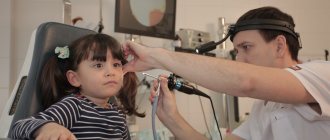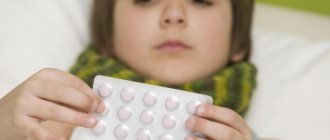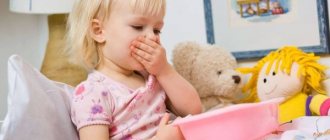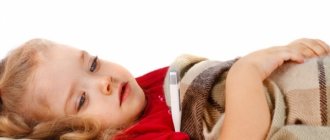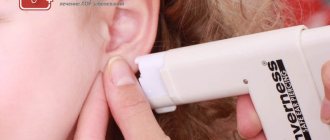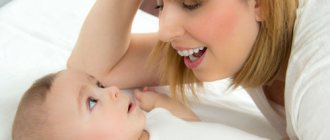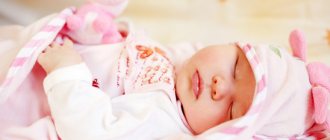At home, it is best to carry out the procedure after bathing, when the baby is calm, relaxed, and the skin is moisturized. Turn your child's head to the side, take a cotton swab, lightly moisten it with warm water and gently wipe the outside of the ear. You only need to clean the part that is clearly visible, that is, the auricle. Penetrating deeply can cause harm. Do not press hard on the delicate skin, do not pull the lobe. Then treat the other ear in the same way. To clean each, use a separate cotton pad or swab. Finally, blot your skin with dry pads.
Skin behind the ears: care features
These places also require cleansing. Dead skin particles and fat produced by the glands accumulate in the delicate fold. Milk or formula leaks there during feeding. If you do not take care of this area, irritation, peeling, and crusts may appear on it. After treating the ears, wipe the skin with a cotton swab dipped in warm water. Then pat it dry with a soft towel and dry thoroughly. If crusts have formed that are difficult to peel, you can first soften them. Apply baby cream or oil to the problem area, and after a few minutes try to clean the crust again.
Madina Abdulaeva, leading pediatrician at the MEDSI Children's Clinic on Pirogovskaya
It is enough to clean the auricle with a cotton swab or disk twice a week. But you need to wipe the area between your ear and head every morning while washing your face. If the skin behind your child's ears is red and flaky, this may be a symptom of allergic dermatitis. Possible causes are early and incorrect introduction of complementary foods, a reaction to hygiene products or washing powder. You need to see a pediatrician.
How, what and when to clean a baby’s ears
Before performing hygiene procedures, it is better to consult a doctor. It makes sense to clean your newborn's ears when you see excess wax on the surface of the ear. On average, ears can be cleaned once every 10 days. Most often, pediatric otolaryngologists recommend using cotton wool for these purposes.
So, how to clean your child’s ears:
choose the evening, preferably after swimming. Usually, after water procedures, babies are calmer and more relaxed. The ears will be slightly moistened, the wax will soften, which will only contribute to effective cleansing; Even before bathing, roll the cotton wool into flagella; place the baby on the changing table or on the bed, sofa
Turn the head to the side so that you can clearly see the baby’s ear (it is advisable to carry out the procedure in a well-lit room); Take a cotton swab and gently wipe the outer (visible) part of your ear. There is no need to go deep into the ear canal so as not to harm the child
Even if there is sulfur there, it does not need to be removed. We have already talked about the beneficial properties of this substance; Clean the second ear using the same procedure.
Don't forget about hygiene behind your ears. After each bath, this area must be wiped dry with gentle movements, like any other folds on the baby's body. To cleanse the skin behind the ears, use cotton pads folded in half.
Gently blot the area behind the ears without applying too much pressure to your baby's skin.
If you choose a time for hygiene other than after bathing, you can use two types of cotton swabs and pads - dry and wet. First, wipe the outer part of the ear with a damp cotton swab and the fold behind the ear with a damp cotton pad.
Please note that the cotton wool should be only slightly wet - no water should flow from it when pressed. After this, blot the baby’s ears with a dry flagellum and disk.
This way the cleansing will be maximum.
Please note that if the baby resists, is capricious, or simply not in the mood, then it is better to perform the procedure another time. Otherwise, you may cause harm with your actions, and the cleansing will not be complete.
In addition, if you forcefully clean your ears, over time you will develop a dislike for this procedure.
Diaper rash and crusts behind the ears
If the area behind the ears is cleaned incorrectly and untimely, crusts and diaper rash may form there. Some parents are not very attentive to the child during feeding. But milk often flows down the baby’s cheeks, heading straight into the fold behind the ear. There it dries and turns into a crust. This brings a lot of unpleasant sensations to the child - he may be capricious, cry, worry. Therefore, regularly check how clean your child’s ears are. If you notice such a crust, then under no circumstances remove it dry. First, wet it with warm boiled water and let it soak.
Then carefully remove with a cotton pad or ball
As for diaper rash, this problem occurs when the skin is not completely dry. Perhaps the parents, without allowing the hair to dry completely, put a cap or cap on the baby. As a result, a wet hat will cause diaper rash in the baby. Another factor that causes diaper rash may be over-wrapping the baby, which can lead to prickly heat. Therefore, do not overdo it when taking care of your child - keep it in moderation. Watch your baby - if he is hot, undress him, if he is cold, dress him. Do not impose your own ideas on the little person about what is good for him and what is bad. The baby's body is no more stupid than its parents.
What not to do when cleaning your ears
In order not to harm your own child, remember a few taboos when cleaning a baby’s ears:
- use cotton swabs or toothpicks/matches with cotton wool wrapped around them;
- use different oils when cleaning your ears;
- start cleaning your baby’s ears if you have long nails;
- try to independently remove wax plug or any foreign object. In this case, you should immediately visit an otolaryngologist.
When to visit a specialist
All children in the first year of life should be examined by an ENT specialist, as well as other specialists. However, there are cases when you should make an urgent visit to a specialist:
- there is discharge from one or both ears;
- there is an unpleasant odor coming from the child’s ears;
- the color and consistency of sulfur suddenly changed;
- the ear is red and inflamed;
- a foreign object has entered the ear canal;
- presence of sulfur plug.
In all of the above cases, do not delay - visit the ENT specialist. We are talking about your child's health.
So, you can and should clean your baby’s ears. The main thing is to adhere to simple rules and carry out the procedure in accordance with the recommendations of specialists.
How to properly clean ear wax
If during the procedure you find a wax plug, do not try to remove it yourself. Firstly, you can push it even deeper, and secondly, you risk damaging your eardrum. It is better to entrust this procedure to a doctor.
According to WHO recommendations, only accumulations of wax that have fallen into the cavity of the auricle or are located in the outer part of the external auditory canal can be removed at home. There is no need to remove wax from the internal auditory canal. It is a self-cleaning organ. The process is helped by microvilli that push the secretion out. Sucking and chewing movements help release earwax.
How and when to cut a newborn's nails
While the baby grows and develops in the womb, his nails grow with him. By the time of birth, all newborn babies have long, “neglected” nails. However, doctors do not recommend cutting them in the first few days. And to prevent the baby from accidentally scratching himself, special cotton mittens are placed on his hands.
But sooner or later there comes a time when the mother must pluck up the courage and trim the baby’s nails - on the hands and feet.
How often. As it grows. It is better to trim your nails more often, but not too short.
What is required. Nail scissors or tweezers. It is better to use the tool that you are used to “wielding”. In other words, if you constantly trim your own nails with scissors, and you decide to shorten your child’s nails with tweezers, you are unlikely to be able to do it carefully the first time. Why experiment? Use the “inventory” that you have confidently held in your hands for a long time.
What to do. It is most reasonable to carry out the “haircut” procedure when the baby is sleeping - if you do everything carefully, the child most likely will not even wake up. But even in this case, when processing each finger, you must firmly hold the baby’s limb (arm or leg) in your hand - otherwise the baby may twitch and get hurt. To avoid unpleasant burrs, remember the rule:
- on the hands, the nails are cut “in a circle” (that is, the corners of the nail plate are cut off)
- On the legs, the nails are cut strictly evenly (corners should not be cut).
Ideally, it would be good to have separate scissors for caring for your baby’s nails. But if you do not see any particular reason for this, it is enough to simply wipe your scissors with a regular alcohol-containing product before the procedure.
How to prevent ear diseases?
To protect your child from ear diseases, it is necessary to take preventive measures. During water procedures, it is important to ensure that water does not get into the child’s ear. If water does penetrate the ear, you can apply a cotton swab to the ear canal to absorb excess moisture. After feeding the baby, it is necessary to place it in a “column”, because during regurgitation, milk can penetrate into the Eustachian tube, which connects the ear to the nasopharynx.
In windy weather, the child should wear a cap that tightly covers the hearing organs. Headwear must be selected according to the weather, otherwise there is a high risk of diaper rash. If you follow the rules for caring for your child’s ears and adhere to preventive measures, you will be able to protect him from pain in this organ.
Important points
The health of the baby is completely in the hands of the parents. After the birth of the baby, it is important to carry out proper hygiene of the baby’s body and carefully care for it. It is impossible to lose sight of more than one organ, including the ears of a newborn; pathogenic bacteria can settle there. Caring for the visible part of the body is considered simple if all requirements are met in accordance with the physiological characteristics of the newborn. The structure of the infant's hearing system is such that excess serous accumulations are released when the child swallows milk, this is worth paying attention to.
Following the algorithm of simple hygienic care for the baby will help to protect against serious health problems in the future; at the initial stage, it will help to discern visible changes and consult a doctor in time.
Basic Rules
Caring for a child’s ears should be carried out taking into account certain rules:
- Cleaning should be done after bathing, when the skin is soft and steamed. This makes it easier to clean off crusts and excess wax.
- You can also clean your ears after finishing feeding.
- If cleaning is carried out after swimming, it is important to ensure that there is no moisture left in the ear folds and shells, otherwise this will cause diaper rash. It is necessary to wipe the areas dry with a soft towel or cotton pad.
- If water gets into your ear while swimming, you need to stick a cotton swab into it.
- If the child is too painful to endure the cleaning procedure, this may indicate the presence of inflammation in the ear. In this case, you will have to contact your pediatrician.
- The fact that the baby is worried about wax plugs will be evidenced by his screaming after bathing and constant rubbing of his ears with his hands. As a result of blockage, a buzzing and itching is created in the ears, and hearing deteriorates. The thing is that after bathing, wax plugs absorb water and increase in volume, which, in turn, puts pressure on the eardrum. In all these cases, you cannot resort to solving the problem on your own; it is advisable to contact an ENT specialist. The doctor will examine the child and remove the plug using a syringe and a powerful jet.
How to carry out the procedure?
Many parents make the serious mistake of using cotton swabs to clean their ears. Such products are suitable for cleaning the outside. Their danger is that they can injure the ear canal and eardrum. It is also important to consider that pieces of cotton wool may remain inside. This will cause discomfort in the ears, so you will have to seek help from a doctor.
How, what and when to clean a baby’s ears
Before performing hygiene procedures, it is better to consult a doctor. It makes sense to clean your newborn's ears when you see excess wax on the surface of the ear. On average, ears can be cleaned once every 10 days. Most often, pediatric otolaryngologists recommend using cotton wool for these purposes.
So, how to clean your child’s ears:
choose the evening, preferably after swimming. Usually, after water procedures, babies are calmer and more relaxed. The ears will be slightly moistened, the wax will soften, which will only contribute to effective cleansing; Even before bathing, roll the cotton wool into flagella; place the baby on the changing table or on the bed, sofa
Turn the head to the side so that you can clearly see the baby’s ear (it is advisable to carry out the procedure in a well-lit room); Take a cotton swab and gently wipe the outer (visible) part of your ear. There is no need to go deep into the ear canal so as not to harm the child
Even if there is sulfur there, it does not need to be removed. We have already talked about the beneficial properties of this substance; Clean the second ear using the same procedure.
Don't forget about hygiene behind your ears. After each bath, this area must be wiped dry with gentle movements, like any other folds on the baby's body. To cleanse the skin behind the ears, use cotton pads folded in half.
Gently blot the area behind the ears without applying too much pressure to your baby's skin.
If you choose a time for hygiene other than after bathing, you can use two types of cotton swabs and pads - dry and wet. First, wipe the outer part of the ear with a damp cotton swab and the fold behind the ear with a damp cotton pad.
Please note that the cotton wool should be only slightly wet - no water should flow from it when pressed. After this, blot the baby’s ears with a dry flagellum and disk.
This way the cleansing will be maximum.
Please note that if the baby resists, is capricious, or simply not in the mood, then it is better to perform the procedure another time. Otherwise, you may cause harm with your actions, and the cleansing will not be complete.
In addition, if you forcefully clean your ears, over time you will develop a dislike for this procedure.
Diaper rash and crusts behind the ears
If the area behind the ears is cleaned incorrectly and untimely, crusts and diaper rash may form there. Some parents are not very attentive to the child during feeding. But milk often flows down the baby’s cheeks, heading straight into the fold behind the ear. There it dries and turns into a crust. This brings a lot of unpleasant sensations to the child - he may be capricious, cry, worry. Therefore, regularly check how clean your child’s ears are. If you notice such a crust, then under no circumstances remove it dry. First, wet it with warm boiled water and let it soak.
Then carefully remove with a cotton pad or ball
As for diaper rash, this problem occurs when the skin is not completely dry. Perhaps the parents, without allowing the hair to dry completely, put a cap or cap on the baby. As a result, a wet hat will cause diaper rash in the baby. Another factor that causes diaper rash may be over-wrapping the baby, which can lead to prickly heat. Therefore, do not overdo it when taking care of your child - keep it in moderation. Watch your baby - if he is hot, undress him, if he is cold, dress him. Do not impose your own ideas on the little person about what is good for him and what is bad. The baby's body is no more stupid than its parents.
What not to do when cleaning your ears
In order not to harm your own child, remember a few taboos when cleaning a baby’s ears:
- use cotton swabs or toothpicks/matches with cotton wool wrapped around them;
- use different oils when cleaning your ears;
- start cleaning your baby’s ears if you have long nails;
- try to independently remove wax plug or any foreign object. In this case, you should immediately visit an otolaryngologist.
When to visit a specialist
All children in the first year of life should be examined by an ENT specialist, as well as other specialists. However, there are cases when you should make an urgent visit to a specialist:
- there is discharge from one or both ears;
- there is an unpleasant odor coming from the child’s ears;
- the color and consistency of sulfur suddenly changed;
- the ear is red and inflamed;
- a foreign object has entered the ear canal;
- presence of sulfur plug.
In all of the above cases, do not delay - visit the ENT specialist. We are talking about your child's health.
So, you can and should clean your baby’s ears. The main thing is to adhere to simple rules and carry out the procedure in accordance with the recommendations of specialists.
Health to you and your children!
Devices for cleaning newborn ears
In the maternity hospital, nurses use cotton swabs to treat the baby. Currently, this remedy has become obsolete and is not practical. Pharmacies offer wonderful cotton swabs with limiters designed to remove wax. This type of stick protects against excessive penetration deep into the ear canal and protects the eardrum from damage.
It is prohibited to use matches with cotton wool wrapped around them, needles, pins, toothpicks, or ordinary cotton wool sticks to clean a child’s ears! The listed hard objects lead to ear injury and subsequent hearing loss.
